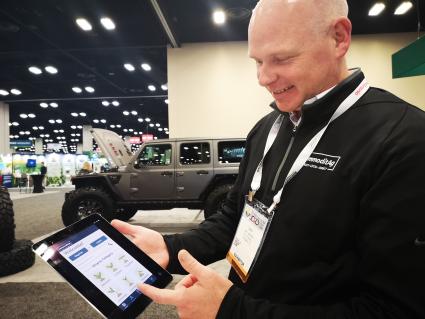Online Sales Find Their Niche in Ag Retail
The COVID-19 pandemic was a “ready or not, here I come” moment for retailers and their grower customers. The digital customer experience, including services like access to account information and data in addition to electronic commerce, is something that many retailers had been at least experimenting with for the last couple of years.
But the realities of social distancing at the cusp of the planting season took these digital tools from “nice to have” accessories to essential factors for staying in touch and making decisions in conjunction with the farmer.
This summer the PrecisionAg Alliance, a consortium of leading technology organizations managed by CropLife® magazine parent company Meister Media, conducted farmer research to gauge use of electronic business and e-commerce, and the results were eye-opening. Nearly two-thirds of respondents indicated they used web-based tools for engaging with retailers. Out of this group, three-fourths used an e-commerce portal for product research and/or purchases.
How the pandemic has changed agriculture in the long run is not entirely clear yet, but an August 2020 Rabobank report on the impact of COVID-19 notes that one apparent impact has been on input purchases.
“It is estimated that the percentage of inputs that are bought through e-commerce platforms in North America is in the low-single digit percentage range,” according to the report. “However, some platforms have quoted growth in year-over-year sales for farm inputs from 100% to 900%. Seasonally, you could put this down to social distancing, but structurally, the increase has been driven by the growth in e-commerce offerings.”
What all this largely pandemic-driven activity means for the present and future of product sales and electronic business is a front-and-center discussion point for retailers trying to anticipate changes in farmer behavior that will carry over into the 2021 planning and buying season. From conversations with leading retailers in the waning months of this growing season, attitudes headed into next year are generally positive.
Responding to Challenge
E-commerce in ag retail dates back more than two decades now, when the crop protection product auction site XSAg was unleashed on a largely unprepared marketplace in 1999. While the site itself was a bigger disruption to the broker market as far as actual sales, the biggest challenge for retailers was price transparency. More specifically, the price of products stripped of their built-in overhead: transportation, storage, prescription services, application, warranties, and of course, rebate and loyalty programs.
The second wave of e-commerce began similarly a few years ago with Farmers Business Network (FBN), but with a more blatant scheme to disrupt and to some extent vilify the traditional distribution channel. Steve Watts, a consultant with Farrell Growth Group with almost five decades of retail and distribution management experience, says that FBN has embraced and trumpeted the notion of “farmer as victim.”
“When FBN came forward with a plan to totally upend the traditional distribution structure in 2016, we knew their ‘farmer as victim’ approach would appeal to a small segment of the farm population,” says Watts. “I have witnessed several cycles of this during my career and it requires ag to be facing difficult times to gain traction. When these conditions are present some farmers become energized by such rhetoric and will show up in meetings and publications. It will gain an almost cult-like following before it gradually runs out oxygen. But these numbers are a drop in the ocean, and definitely do not represent the opinions of the majority of farmers or crop input transactions in the U.S.”
Still, against a far more consolidated marketplace amid dark economic days in the Corn Belt, from the standpoint of e-commerce FBN provided a wake-up call to the distribution channel. Leading retailers were looking to claim their own beachhead in the digital landscape, and e-commerce became a key component.
Over the last four years, many retailers have settled into approaches that matched their organizations’ mission and goals. Some have developed their own internal systems, while others have partnered with software companies to create white label e-commerce offerings. By all accounts, the electronic connectivity afforded by a digital connection with the farmer was an enormous boon to business and services in 2020.
Internal Efforts: Enhancing the Core System
Since launching its agronomic digital platform in 2018, Nutrien Ag Solutions has experienced steady growth, and in 2020 expects to surpass its goal of reaching $1 billion in internet sales by year’s end, according to Cameron Holbrook, Vice President, Digital. “The platform has continued to exceed our expectations and will change the baseline of utilization as we go into 2021,” he adds. “Its success offers us the opportunity to pursue new data-driven offerings in the future.”
Critical to its success is the system is not exclusively a platform for farmers to order products online. It doubles as the de facto ordering system for the Nutrien representative. For example, over the course of off-season planning, agronomists can place product recommendations in a digital shopping cart based on preliminary discussions. When the agronomist and farmer finalize the plan, the order can be confirmed or adjusted and finalized at the same time.
“Rather than displace or diminish the need for the retailer, this streamlines the ordering process and focuses conversations on increasingly complex agronomic recommendations,” says Holbrook. In the future, Nutrien sees potential around sustainability and providing farmers guidance and data management services that allow them to participate in programs that deliver a premium.
WinField United is investing in its retail network to help deliver an omnichannel experience in which the retailer and the farmer-customer can share data to help reduce risk and increase predictability from both an agronomic and economic standpoint. President Brett Bruggeman sees the acceleration of farm consolidation and the higher level of service large farmers require as a significant future opportunity. “How can we serve that top tier professional farmer?” he says.
Plug-and-Play E-commerce
Ag retailers that operate outside the scale of the large, integrated agribusinesses have had the opportunity to create an e-commerce presence without having to invest in an IT department. Two of the movers in this space, AgVend and CommoditAg, are enjoying success as the pressure to engage farmers electronically grows.

John Demerly demos the CommoditAg site on the 2020 Commodity Classic show floor.
Back in late February, we spoke with John Demerly, Chief Executive of CommoditAg at Commodity Classic — just before coronavirus hit. A veteran of Corteva AgriScience U.S. business, he joined the young farm input e-commerce company in 2017.
The pandemic did not dramatically increase the overall e-commerce trend in the farm community, he says but it did prompt growers to explore their options. “They were trying us out, buying a little at a time. The awareness of e-commerce and consumer online buying habits set the stage for more rapid adoption of e-commerce in the future.”
Demerly has also witnessed the pandemic lead to more e-commerce buy-in from retailers. CommoditAg has added four new retail partners to its network since February, bringing on 10 to 15 new retail warehouse locations acting as its fulfillment centers. The company now has 14 retail partners with over 45 fulfillment centers from Ohio to Colorado and south into Texas. While it delivers anywhere in the U.S., the presence of the fulfillment centers makes for a better customer experience.
“(Ag retailers) are really thinking through what their multichannel approach looks like, and how they embrace e-commerce as part of that,” he says. Instead of viewing it as a threat or choosing a single e-commerce platform for necessity’s sake, retailers are increasingly approaching the channel from a much wider lens: How to segment their customers, how to go to market, how to choose the partners with whom they work.
“We’ll see nearly every progressive retailer out there adopt some form of e-commerce, whether it be their own e-storefront or being part of a marketplace like CommoditAg, or better yet both,” Demerly says, adding that not all e-commerce players are the same. AgVend, with its recent shift away from its marketplace to building e-commerce sites for retailers, he sees as “a very complementary strategy” to that of CommoditAg.
Likewise, at the supplier level, the winds have changed in favor of e-commerce amidst COVID. In prior years, the company needed to recruit suppliers to join its marketplace, but now suppliers come knocking on its door, hoping to jump aboard the CommoditAg site in addition to traditional brick-and-mortar and other online distribution channels.
Its retail partners are adding to the marketplace by selling their own products and brands to reach a broader set of customers. Similarly, it’s also seen more product categories seeking a place on the platform. Back in February, crop protection dominated its offering, but it’s since expanded to seed, agricultural lubricants, micronutrients, biologicals (it added bioinsecticide player Vestaron to its network in September), animal nutrition, and now data services in a partnership with Main Street Data selling its MarketVision product.
Startup suppliers that have solid products but lack marketing capabilities and channel access are approaching CommoditAg to link up, too, akin to a third-party seller on Amazon.
In the next few months, it is set to add agricultural equipment for the precision ag space, details of which are still under wraps.
“Our objective is to continue to provide transparent, comprehensive, and convenient offer to farmers. We are focused on building awareness and most importantly, trust: trust in the process, trust in the fact that the farmer can buy something online easily, and trust not only the product they’re receiving but also the delivery and fulfillment,” Demerly adds.
Moving to the White-Label Model
AgVend was one of a handful of companies that recognized that competitive pressure from manufacturers and massive integrated retailers seeking to dominate farmer product procurement through e-commerce was growing fast.
Retailers were seeking ways to keep up without having to invest in proprietary software programs, so the company provided an opportunity for retailers to get in the e-commerce game through an open platform called AgVend Marketplace.
In April, AgVend launched a white-label product line that allowed direct connection between the farmer and the distribution channel partner. “The Grower Portal solution combines the convenience of the Marketplace with our partner retailers’ pre-established brand, team, and relationships with their customers,” says Rosenberg. “The digital platform allows quicker, more streamlined communication and gives both retailers and growers instant access to powerful data that can influence business decisions.”
The gravitational pull of the Grower Portal model led the company to sunset its Marketplace portal last month.
“Over the past three years, we’ve learned a great deal about how growers want to do business, and many of those lessons are reflected in our new Grower Portal product. Our biggest takeaway has been that 90% of growers still prefer to work directly with their local, trusted retailers. However, the majority of that segment wants a more digitally integrated way to interact,” says AgVend CEO Alexander Reichert.
The Grower Portal product line has been quick to establish traction within the market. As a result, AgVend reports that it grew its year-over-year revenue by 20X in Q2 and expanded its team by 25% as a result of the response to the Grower Portal model. They also claim that 15% of the top 50 companies in the CropLife 100 retailers as partners for this new product.








